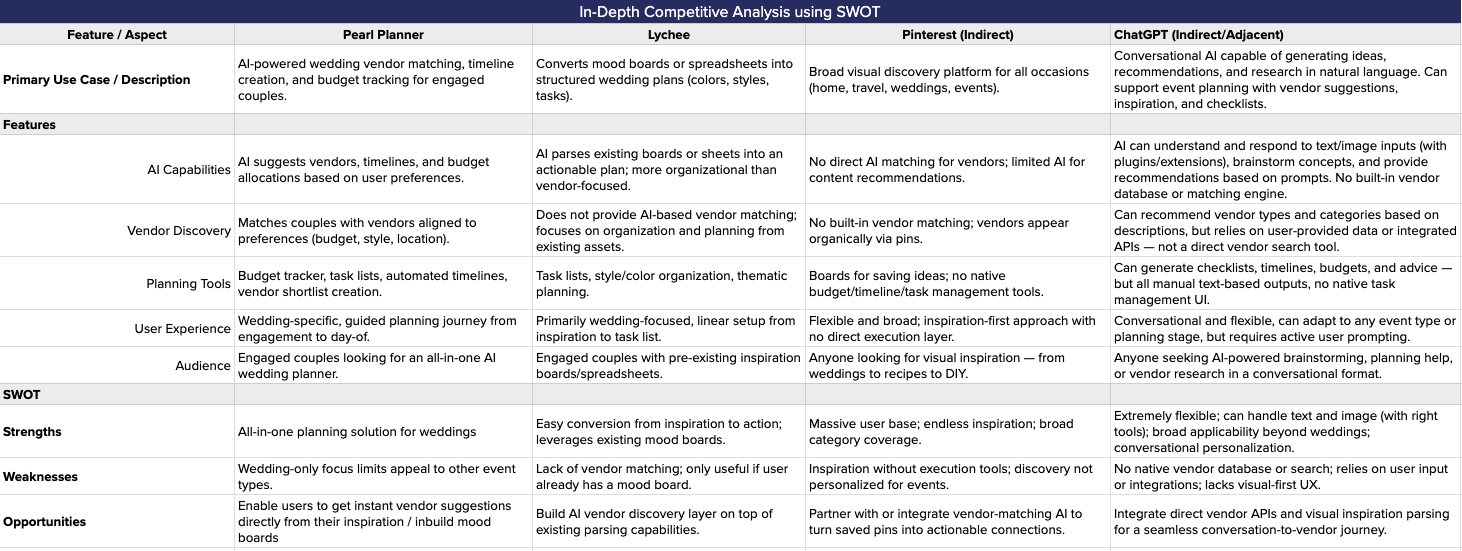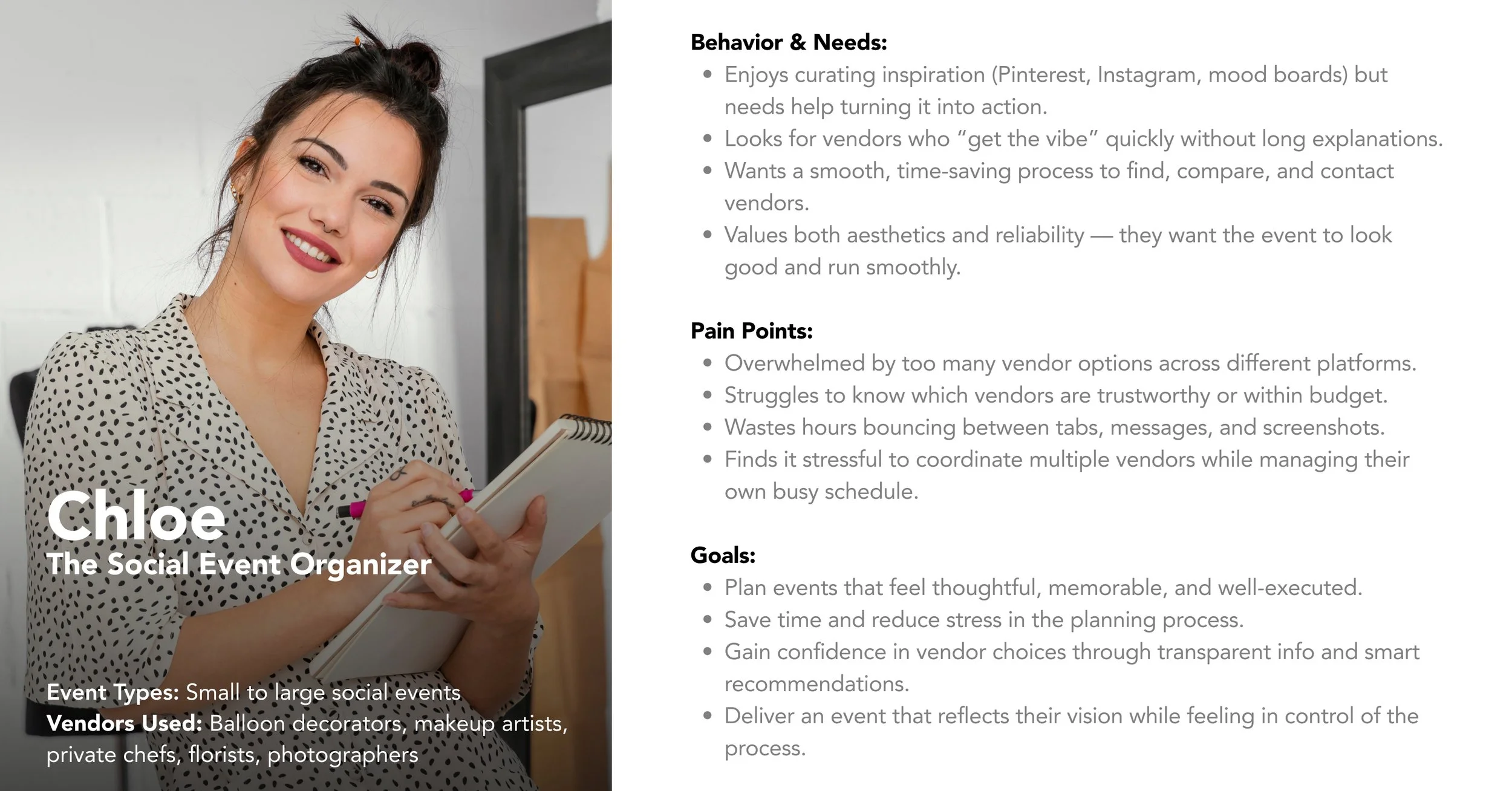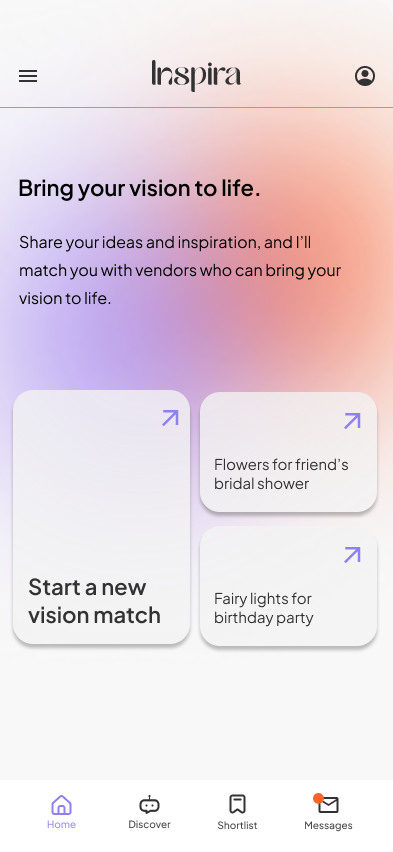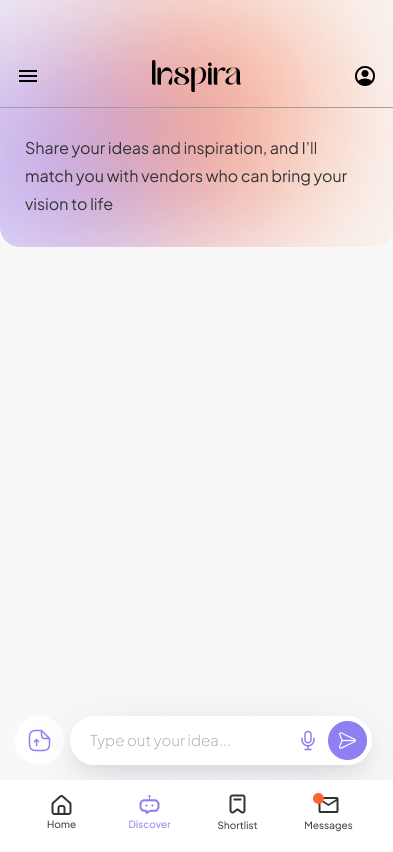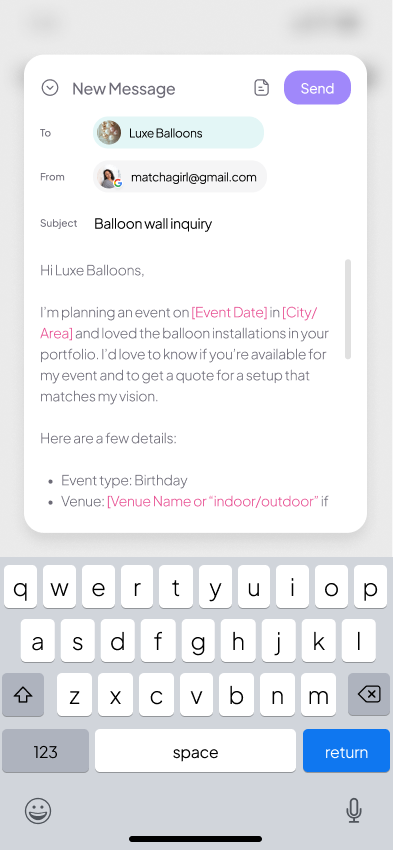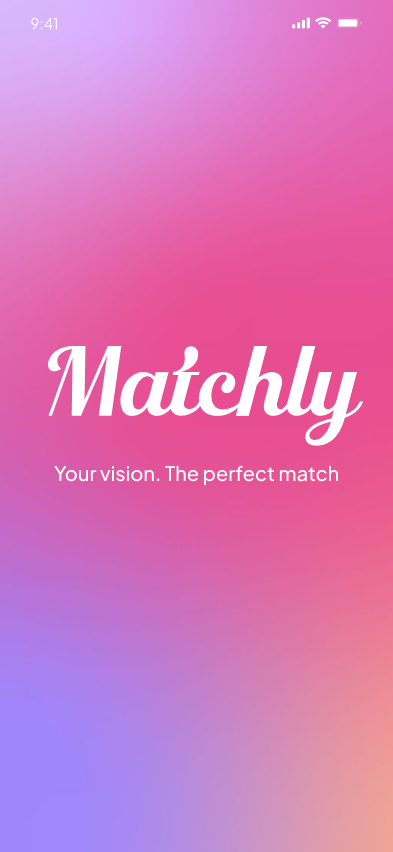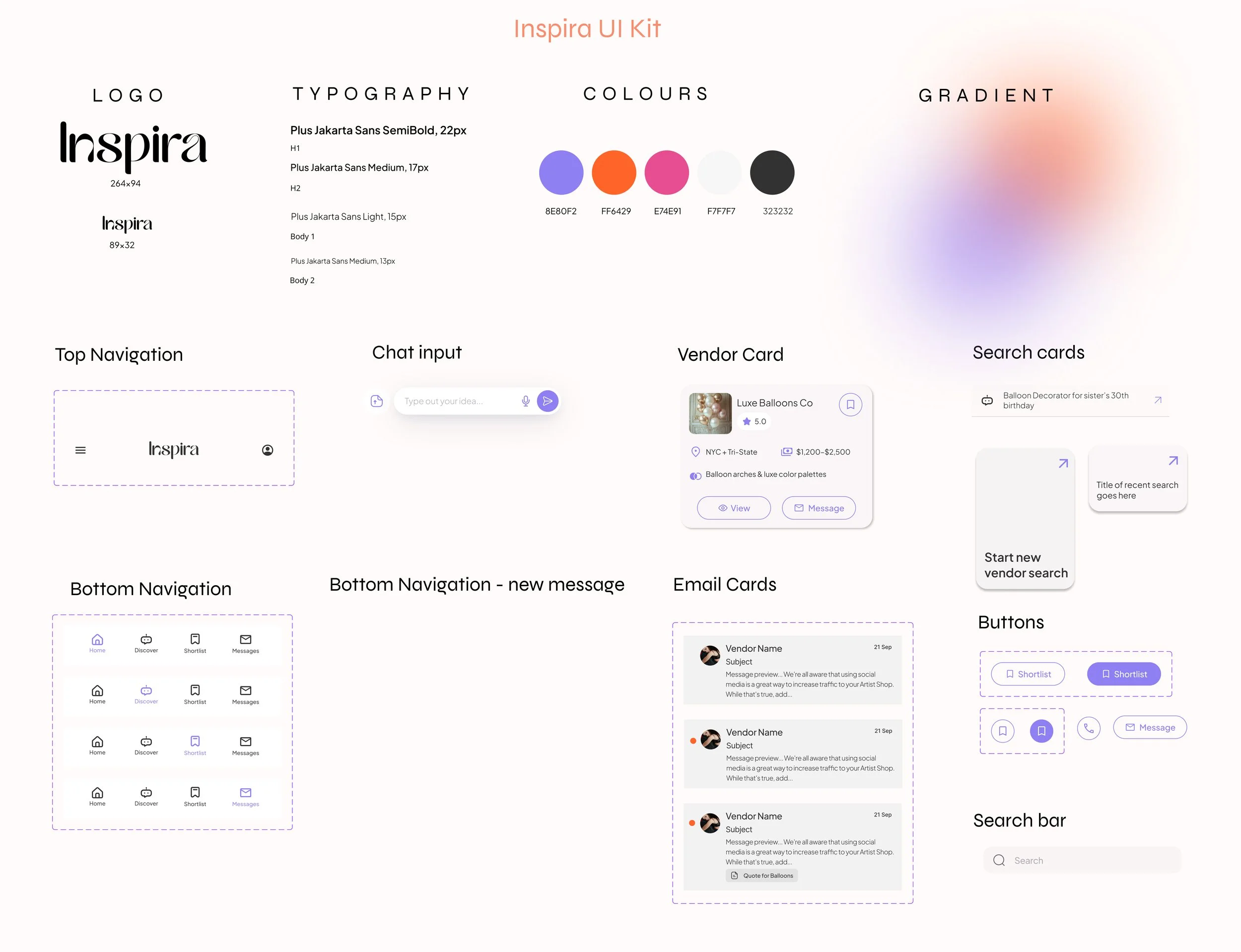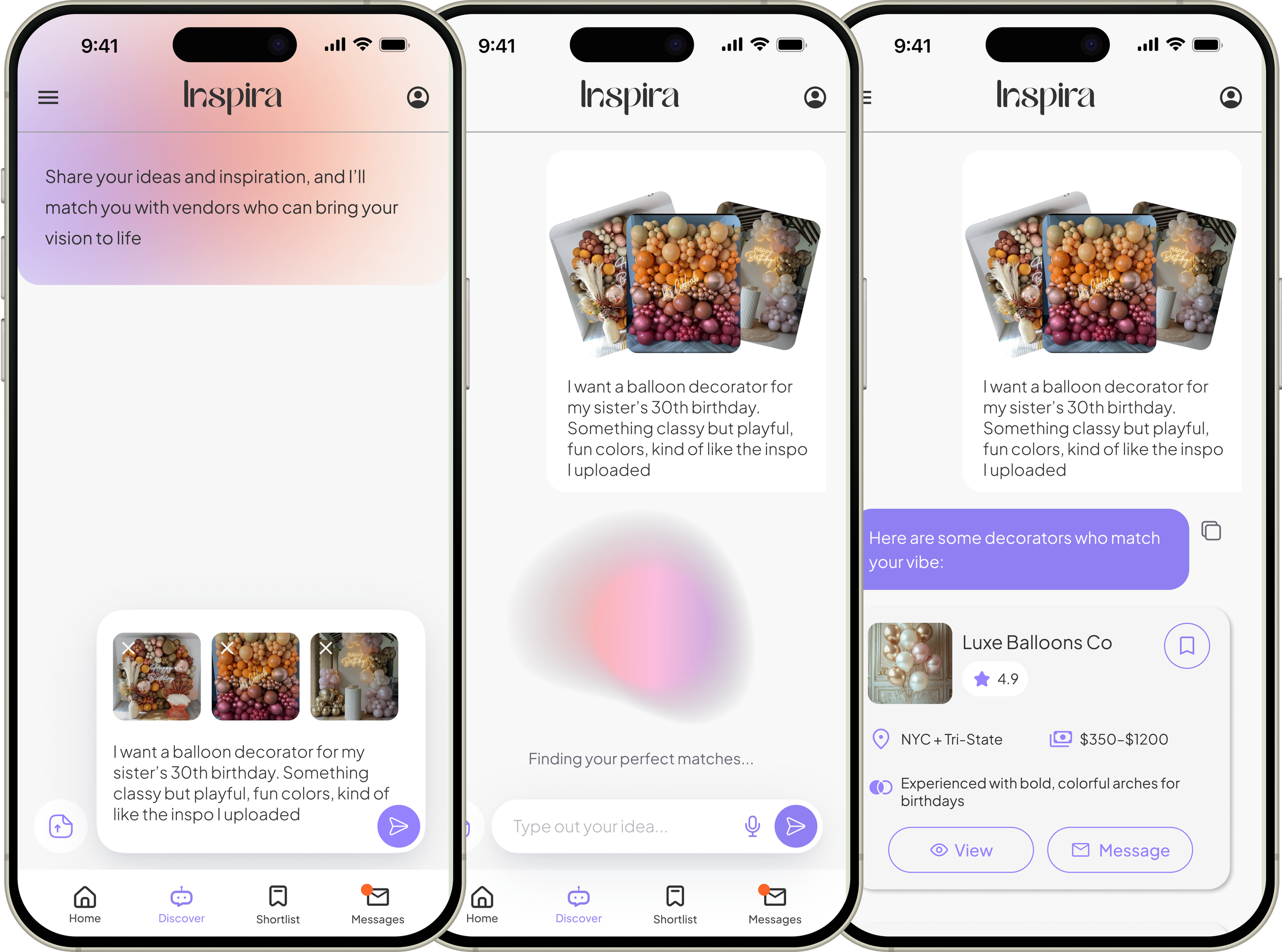Inspira: End to End Mobile Application Design
Overview: Inspira is an AI-powered vendor matching tool that helps people bring their vision to life without the stress of endless searching. By simply describing what they need or uploading inspiration images, users get matched with vendors who can make it happen
Role: Sole Product Designer, Researcher, Brand Designer
Tools: Figma, FigJam
Duration: 6 weeks
Planning a celebration should feel exciting, but finding event vendors to bring your vision to life often makes it stressful.
Finding the right vendors like balloon decorators, florists, caterers often means bouncing between Pinterest boards, Instagram profiles, Google results, and endless DMs. The process is messy, fragmented, and overwhelming.
I wanted to change that.
That’s where Inspira comes in: an AI-powered vendor matching tool that helps people bring their vision to life without the stress of endless searching. By simply describing what they need or uploading inspiration images, users get matched with vendors who can make it happen.
Over six weeks, I designed Inspira from the ground up: research, user flows, wireframes, usability testing, and branding. My role was end-to-end product design.
So I researched into how people currently find vendors today
User Interviews
To understand this problem more deeply, I conducted seven user interviews with people who had planned birthdays, weddings, showers, or other events.
“I found vendors, but I couldn’t tell if they were reliable.”
“I had 12 tabs open between Pinterest, Instagram and Google — it was exhausting..”
“I knew the vibe I wanted, but had no idea how to find someone to do it.”
From these conversations, three key insights stood out:
1
People loved curating inspiration but struggled to turn it into action.
2
Trust was critical — reviews and proof of past work drove confidence.
3
Overwhelm was constant — too many options and no clear way to filter.
Competitive Analysis
To build on what I learned from users, I also looked at the tools people were already using from Pearl Planner and Lychee, to Pinterest, and even AI platforms like ChatGPT. Each had something useful, but none solved the whole problem
Across competitors, the same pattern emerged: tools either focus on inspiration without action (Pinterest), organization without discovery (Lychee, Pearl Planner), or ideas without execution (ChatGPT). None bridged all three needs.
This confirmed the opportunity for Inspira: a platform that helps people move seamlessly from inspiration → trusted vendor discovery → action.
Which led me to define what Inspira needed to solve
From these insights, the design goals became clear:
1
Simplify the vendor search.
2
Build trust with transparent, helpful vendor information.
3
Streamline the journey from inspiration to contact.
To frame the challenge, I defined the problem as a How Might We:
How might we help users turn inspiration into reality by centralizing vendor discovery and connecting them with vendors who can deliver their vision?
How Might We
Persona
Next, to make sure these features were grounded in real needs, I mapped them back to a representative user persona.
Meet Chloe, the social event organizer: Chloe loves hosting celebrations, but planning often leaves her overwhelmed. To find vendors, she juggles Pinterest boards, Instagram saves, Google searches, and group chat recommendations — all of which take hours and still feel uncertain. What she really needs is a tool that gives her curated vendor options she can trust, explains why each one is a fit, and makes it easier to compare and reach out.
With Chloe’s needs in mind, I translated the problem into a set of key features for Inspira:
AI-powered matching to reduce option overload,
vendor cards that clearly explained why a vendor was suggested,
shortlisting to help users organize and compare, and
prepopulated inquiries that lowered the barrier to reaching out.
From user flows to high-fidelity screens, I shaped the design into a real product.
With these goals and features defined, I moved into design to bring Inspira to life. I began with site maps and user flows to outline the end-to-end experience and help me identify the key screens that I needed to design
Low-Fidelity Wireframes
Then sketched low-fidelity wireframes to explore layouts and interactions.
High-Fidelity Wireframes
From there, I moved into Figma to iterate through high-fidelity designs. Some key design decisions included:
Home page with options to start a new search or navigate to previous searches
Discover page with options to either type out inspiration description or upload inspiration images
Shortlist - A simple way to save and compare vendors. Each vendor card in the shortlist includes details of location, why the vendor was matched, vendor rating and price range
Vendor profile where users can view more details about the vendor including photos of their work, service details and integrated messaging
AI prepared inquiries that users can send in one tap when they choose to message the vendor
Branding and Visual Identity
Branding and Visual Identity was an important part of the process. The tool was initially called Matchly with pink and orange colors, but usability testing revealed it gave off “dating app” vibes — too feminine and misleading. That feedback inspired a pivot to Inspira: a name that highlights vision and creativity.
With the new brand direction, every design decision became more intentional. I created a logo that feels modern yet creative, echoing the idea of “inspiration and events, powered by AI.” Typography choices followed the same principle — clean and modern but still approachable, so the product feels trustworthy without being rigid.
I also designed with a consistent component system. Buttons, cards, and navigation patterns were standardized to ensure a seamless experience and reusability across the product. This not only made the designs scalable and efficient to update, but also reinforced brand consistency across screens.
The refreshed brand direction ultimately shaped everything from color palette and logo to micro-interactions — creating an identity that feels inspiring, approachable, and distinctly different from a dating app.
Next, I tested the prototypes to see if the matching and shortlisting process worked in practice
The goal of the usability test was to evaluate how intuitive and useful Inspira’s AI-powered vendor matching and shortlisting process is. Six participants were asked to plan a birthday party using the tool, completing tasks such as requesting vendor matches, reviewing suggested vendors, adding vendors to a shortlist, exploring profiles, and initiating communication.
Success criteria: Users should be able to complete all tasks without assistance, find the process clear, and describe it as useful.
Key findings:
Ease of use: All participants found Inspira intuitive and straightforward.
Vendor cards: The “reason for match” was seen as highly valuable. Missing elements included reviews/testimonials.
Shortlisting: Clear and effortless across all participants.
Profiles: Helpful and detailed; some wanted a call option.
Communication: Prepopulated AI messages lowered friction and were well-received.
From concept to a tool people said they’d use for real events
Testing confirmed Inspira’s core value: people found the tool intuitive, appreciated the vendor cards, and loved the ability to quickly shortlist and reach out. The strongest validation was that every participant said they’d use Inspira for real events.
But this project taught me that solving the functional problem — simplifying vendor search — wasn’t enough on its own. Trust, credibility, and perception mattered just as much. It also showed how my product management background shapes my design approach: deliver an MVP that solves the immediate pain point, while mapping a roadmap for how the product can scale.
Next Steps
P2: Add reviews/testimonials to build vendor credibility.
P2: Create an Event Organizer Dashboard as a central hub for vendors, details, and messages.
P2: Integrate Pinterest/Instagram boards so inspiration flows directly into matches.
P3: Layer in availability calendars and booking for a fully streamlined planning process.






